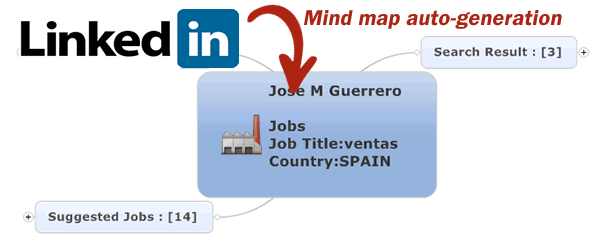One of the powerful capabilities of mind mapping software is the ability to pull in data from numerous sources – including SharePoint, Outlook, RSS feeds and more. But what if mind maps could be auto-generated for larger data sets? That’s a challenge that Jose Guerrero, managing director of InfoSeg S.A. has been working hard on, and he’s made some fascinating progress.
The harbinger of this auto-mind map generation revolution is IM-LKDIN, an application I told you about last year that can conduct searches of your LinkedIn network of contacts and then display the data in a Mindjet (formerly MindManager) mind map. Since IM-LKDIN debuted last year, Jose and his team have been quite busy, not only expanding its capabilities to include company and job searches, but also pioneering applications in industries like insurance, banking and pharmaceuticals.
I recently had a chance to interview Jose about his current efforts to map large data sets. Here’s what he had to say:
 Chuck Frey: It looks to me like the idea of auto-generating maps from data queries has a lot of promise. How does this differ from making a query from within an existing mind map?
Chuck Frey: It looks to me like the idea of auto-generating maps from data queries has a lot of promise. How does this differ from making a query from within an existing mind map?
Jose Guererro: There are five general cases. You can need information located in flat files, in data bases, on the Web, in an xml file with a certain format and in an xml file with a standard format. We have done applications in the three areas. In IM-RATIOS, information is extracted from CSV files generated in SAP. In IM-Broker, information is extracted from data bases. In IM-LKDIN information is extracted from LinkedIn using an API. We have a standard format for xml files, if the information is in that format then we have a program that generates mind map files automatically.
Frey: Can you briefly explain what IM-LKDIN does?
Guerrero: My first idea for IM-LKDIN was simply to read the information about the contacts of a person an display them in a series of mind maps. The most obvious groupings were by country, last name, company and industry.
Frey: What advantages does IM-LKDIN give to the average businessperson who is a LinkedIn member?
Guerrero: I think that IM-LKDIN should be something integrated into LinkedIn. They have InMaps but that is simply a tool to visualize the network of contacts. IM-LKDIN visualizes the network, groups it by several concepts, creates the mind maps and opens all possibilities of the multiple software systems to manage mind maps. This is something that should be integrated into LinkedIn. But it is not. So IM-LKDIN is extremely useful.
Frey: What’s next for IM-LKDIN?
Guerrero: As results looked very interesting I decided to go a little further and extend IM-LKDIN to create mind maps for the results of company search and job search. This makes IM-LKDIN more useful, it is not just a simple display of your contacts and can be much more useful to other types of users.
Now I am working in something that I call “From-To” analysis of the flow of employees of a company. The idea is to choose a company with many employees in LinkedIn and create a Mind Map that offers several types of information
- Employees working in the company now
- Companies where present or past employees of the company work before joining this one
- Companies where past employees of the company are working now
This type of analysis can be very interesting for companies with many past and present employees.
The future is open to other possibilities but I guess the possibility of integrating IM-LKDIN into LinkedIn would be something really interesting.
Frey: Your website contains some examples of mind maps generating from insurance, banking, pharmaceutical and other types of data. It looks like you’ve been busy! What types of possibilities are you exploring?
Guerrero: In the past few weeks I have been exploring two new areas. The first one was what I call eMapMail. It is a system to manage complex email requirements I have had this idea in mind for a long time and in the end I have created a solution.
The second is an interesting project related to e-publishing. For many years PDF has been the standard for scholarly e-publishing. However, PDF has serious limitations. For example it lacks context and structure. It is something linear. Besides that you can only include sounds, videos, large data sets, etc. as hyperlinks to web pages. I have created a system using mind mapping that solves most of those problems.
But I am finding new ideas almost daily. It is only my limitation of resources that reduces the possibilities of new applications. But the future looks promising. When I have time I will create something related to brain-computer interfaces. The idea of offering the possibility of creating and working with mind maps to disabled people is something very interesting. Even in the case of healthy people, this would open a new world of possibilities.
Frey: I viewed a SlideShare presentation where you’re suggesting that this technology could be used for e-discovery and tracking complex e-mail communications. How does that work?
Guerrero: The idea is that instead of sending a flat linear message, you send a mind map. The Mind Map can include several issues and can also be sent to several people. The mind map can be stored in the cloud and shared with all the people who have received the message. People can start their answers by using a callout on any relevant topic. From that callout, the author can create a new sub-mind map with any number of levels. Every callout has a different color corresponding to the author. Every time a modification is made on the cloud, a simple email message can be sent to all recipients and to the author of the original mind map. In this way, people receive very simple ordinary email messages and can go to the cloud to study the whole message in the form of a mind map. It is a very simple system but extremely powerful for complex situations involving many people and many issues.
Frey: What are the key advantages of this type of data visualization?
Guerrero: In general, we can say that the more complex an information or a communication is the more useful is using mind mapping. There many advantages but the two key points are context and structure. If you use linear systems to exchange information (PDF with many pages) or you use hyperlinks (website), a very important problem is that of losing context. It is very easy to get lost in the middle of lots of pages. The other problem is structure. It is very complicated to remember the structure of the content you are navigating. In mind mapping these two problems are minimized. In a mind map you can see the table of contents and the detail at the same time. No more navigation problems. Mind mapping is an extremely old and simple technique but, now that we can automate the generation of mind maps, it has an incredible amount of advantages.
Frey: What are the advantages of displaying this data in the form of a mind map, versus other types of data visualizations?
Guerrero: It offers the same advantages as multiple PDFs, charts, videos, maps, sounds, images, icons but on the top of that, all information is included in a single file and with dynamic navigation that preserves context and structure.
Frey: How does this type of data visualization help people to identify patterns and solve problems?
Guerrero: I think that the basis of problem solving is the need to structure information. Before we can solve any problem, we need to organize and classify information. We have to “see” the problem and mind maps help us to do it.
Frey: What is the ultimate potential of mind map auto-generation, in your opinion?
Guerrero: I think mind mapping is the PDF of the 21st century. PDF is uni-dimensional (in a certain sense) and mind mapping is multidimensional. I think that all software should have a function to export information as a mind map. All exchange of information in the academic or business worlds should be done through mind maps, at least in the case of complex information. All collaboration on the internet should be done using a certain mind map structure.


Leave a Reply